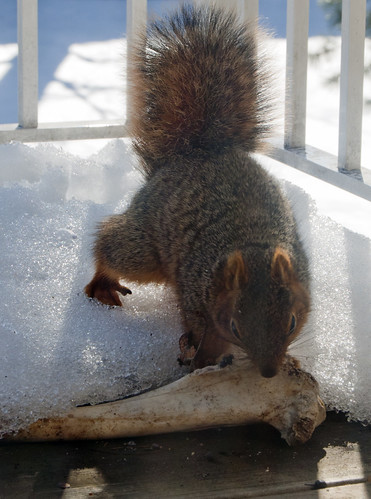Last October, during one of our many forays onto the property of the Matthaei Botanical Gardens, we found the tibia of a deer. Before winter arrived, I left the leg bone out on the deck of our apartment, in the hope that the local fox squirrels would find it tasty and useful. They discovered it almost immediately, and soon were chewing away! It's amazing just how loud the sound of gnawing can be.
Today, I was finally able to photograph a squirrel in the act of gnawing. In just a few minutes, it had made quite a dent in the bone.

Here's a view of the tibia, after this most recent gnawing:

Squirrels gnaw on bones for a couple of reasons. Firstly, bones are full of calcium and other minerals, nutrients that rodents need to survive. Shed deer antlers are also a favorite of porcupines, mice, and squirrels.
Secondly, the incisors of rodents grow for as long as the animal is alive, and gnawing keeps them worn down to a manageable length. If a rodent's teeth aren't used on a regular basis, the animal will undoubtedly develop life-threatening dental problems. I have seen gruesome images of squirrels and other rodents with incisors that have curled and grown through their skull. Gnawing on bones, as well as nuts, antlers, and plant matter, keeps rodent incisors healthy.
Interestingly enough, bone-gnawing is as old as the dinosaurs, as this article reports.

Squirrels gnaw on bones for a couple of reasons. Firstly, bones are full of calcium and other minerals, nutrients that rodents need to survive. Shed deer antlers are also a favorite of porcupines, mice, and squirrels.
Secondly, the incisors of rodents grow for as long as the animal is alive, and gnawing keeps them worn down to a manageable length. If a rodent's teeth aren't used on a regular basis, the animal will undoubtedly develop life-threatening dental problems. I have seen gruesome images of squirrels and other rodents with incisors that have curled and grown through their skull. Gnawing on bones, as well as nuts, antlers, and plant matter, keeps rodent incisors healthy.
Interestingly enough, bone-gnawing is as old as the dinosaurs, as this article reports.




That's what your fox squirrels look like?!? He must be fat and fluffy for winter! Ours are usually a bit sleeker and yellower in color (though they can still get pretty fat).
ReplyDeleteYup! He's definitely fluffed up, but this particular squirrel was also a smaller/younger individual... they get a lot larger than that around here!
ReplyDeleteRodents are amazing. My rats love the rare treat of a chicken leg bone!
ReplyDelete